NAGOYA UNIVERSITY
Autoware User’s Manual
Version
1.1
Autoware ver.2016.Sep.12
�
Table of contents
1. About This Document ....................................................... 4
2. ROS and Autoware .......................................................... 5
Robot middleware - ROS ...................................................... 5
ROS Features ......................................................................................... 6
Autoware ............................................................................... 7
3-D Map Generation and Sharing ........................................................... 8
Localization(NDT:Normal Distributions Transform) .............................. 8
Object Detection ...................................................................................... 8
Route Generation .................................................................................... 8
Autonomous Driving ................................................................................ 9
User Interface .......................................................................................... 9
Platform structure for Autoware .......................................... 10
Perception/Recognition ......................................................................... 11
Judgement/Operation/Localization........................................................ 12
Path Planning ........................................................................................ 13
Data Loading (3-D Map, Database, Files) ............................................ 14
Device Drivers and Sensor Fusion........................................................ 15
Interface for Smart Phone Applications ................................................ 16
Utilities and Others ................................................................................ 16
3. Operating Autoware ..................................................... 17
Preparations ....................................................................... 17
Demo Data ............................................................................................ 17
Runtime Manager Launching ................................................................ 18
RViz Configuration ................................................................................ 19
Operating Quick Start ......................................................... 19
Load map(Quick Start) .......................................................................... 19
Load driver(Quick Start) ........................................................................ 19
Autoware Main Functions ................................................... 20
Localization(NDT:Normal Distributions Transform) ............................ 20
Object Detection .................................................................................... 22
Path Planning ........................................................................................ 23
Path Following ....................................................................................... 23
Dynamic Map ........................................................................................ 24
AutowareRider .................................................................... 27
AutowareRoute...................................................................................... 27
Features ................................................................................................ 27
AutowareRider Launching ..................................................................... 27
Path Planning Application Usage .......................................................... 30
Send Path data to ROS PC ................................................................... 30
CAN Collection Application Usage Data ............................................... 30
Send CAN Data to a ROS PC ............................................................... 31
Start Launch File ................................................................................... 32
�
4. Autoware User Interface Details ................................... 33
Runtime Manager ............................................................... 33
Runtime Manager – Quick Start Tab................................... 34
Runtime Manager – Setup Tab ........................................... 36
Runtime Manager – Map Tab ............................................. 38
Runtime Manager – Sensing Tab ....................................... 40
Runtime Manager – Computing Tab ................................... 43
Runtime Manager – Interface Tab ...................................... 48
Runtime Manager – Database Tab ..................................... 50
Runtime Manager – Simulation Tab.................................... 52
Runtime Manager – Status Tab .......................................... 54
Runtime Manager - Topics Tab .......................................... 55
ROSBAG Record Dialog ..................................................... 56
RViz ...................... エラー! ブックマークが定義されていません。
AutowareRider .................................................................... 59
AutowareRoute ................................................................... 64
5. System Setup ............................................................... 66
Installation ........................................................................... 66
OS ......................................................................................................... 66
ROS ....................................................................................................... 67
OpenCV ................................................................................................. 68
CUDA(if necessary) .............................................................................. 69
FlyCapture(if necessary) ....................................................................... 69
Autoware ............................................................................................... 70
AutowareRider(if necessary) ................................................................. 71
canlib(if necessary) ............................................................................... 72
SSH Public Key Generation(if necessary) ............................................ 72
6. Terminology ................................................................. 73
7. Related Documents ...................................................... 76
�
A U T O W A R E - U S E R S - M A N U A L
Chapter
1
1. About This Document
This chapter describes the purpose of this document.
There are following two documents provided by Nagoya University.
- Autoware User’s Manual
- Autoware Developer’s Manual
Page 4
�
A U T O W A R E - U S E R S - M A N U A L
Chapter
2
2. ROS and Autoware
Before operating Autoware, ROS and Autoware are described in this chapter.
Robot middleware - ROS
R
ecently, the wide range potential of robotics has been focused by not only robotics
experts but also non-robotics experts to join robot development. It is believed that
this trend leads robotics to advancement and developments to other domains.
However, robot development is getting harder because the advancement and the complexity
of robot functions have been increased. Unlike PCs and smartphones, robotic development
has considered various hardware, OS, programming languages. Hence, the differences have
mainly been obstructed for robotic developers as well as robotics experts to join robot
development.
To solve the problem, the demand of making common platforms has been increased, and
some platforms have been published. Within a common platform, developers can combine
various software published by other developers, and speed up development by reusing them.
Therefore, it is expected that developers can more focus on fields of interest.
ROS (Robot Operating System) is a framework1 for robotic software development. It was
developed by Willow Garage in U.S. OSFR (Open Source Robotics Foundation) has currently
maintained it. The open sourced ROS has mainly been used by communities in U.S. and
Europe as well as communities in Japan.
Note that ROS has “OS” in its name, however, it is not “OS” like Windows or Linux. It is a
middleware that runs on UNIX based OS.
1 https://en.wikipedia.org/wiki/Willow_Garage
Page 5
�
A U T O W A R E - U S E R S - M A N U A L
ROS Features
① Library and tools
ROS provides library and tools for robotic software development. The primary libraries
and tools are listed as follows:
Original build system (Catkin)
Image processing library (OpenCV)
Data logging tool (ROSBAG)
Visualization tools for data and software state (RViz)
Coordinate transformation library (TF)
Qt based GUI development tool (RQT)
② Inter-process communication
ROS uses message passing with topics of publish/subscribe form for inter-module
connection/cooperation
inter-process
communication mechanism in which a sender can send data to one or more receivers. This
feature enables us to design distribution systems. In ROS, processes called node are
launched and each node is run independently. In communication between nodes, by
following the publish/subscribe scheme, a node writes messages (publish) into a topic and
another node reads the messages (subscribe) of the topic.
frameworks. Here, message passing
is an
③ File components
・bag file (ROSBAG)
In ROS, all the messages of topics are recorded and time-stamped into a .bag file
called ROSBAG. This file can be used for replaying the messages on RViz as
same timing as recording. In robotic development, it is difficult to synchronize and
analyze the interactions with multiple sensors at the same time, but ROS enables
efficient analysis and debugging robotic systems. In addition, since the recorded
messages can be replayed repeatedly, this feature allows developers to debug
their systems without actual sensors.
・Launch file
A “Launch” file is used to start multiple nodes at the same time. The launch file
contains the nodes to be started and their parameters written in XML format.
Page 6
�
A U T O W A R E - U S E R S - M A N U A L
Autoware
A
utoware is open source software based on ROS. Autoware is pushed on Github for
autonomous driving research and development. Most of autonomous driving
system consist of recognition, judgment, and operation. Autoware provides
necessary functions, such as 3-D map generation, localization, object recognition, and
vehicle control, for autonomous driving.
Figure 1 Autoware overview
Autoware uses LIDAR (Light Detection and Ranging) and on-vehicle cameras to localize the
ego-car position. In addition, Autoware can detect surrounding objects, such as pedestrians,
vehicles, traffic lights etc., by using LIDAR and GNSS (Global Navigation Satellite System).
The making judgments of driving/stopping at lanes or intersections are performed with an
embedded multi-core CPU. Operations of controlling vehicle behaviors utilize conventional
on-vehicle control mechanism, while support systems such as driving assistance and safety
diagnosis support, use multi-core CPU.
Page 7
�
A U T O W A R E - U S E R S - M A N U A L
3-D Map Generation and Sharing
The most notable feature of Autoware is the fact that the autonomous driving of Autoware
uses a 3-D map. The 3-D map, unlike 2-D maps used in car navigation system, is a map
including various information, such as roads and all the still objects around the roads. The
3-D map will play a critical role in deploying autonomous driving into the real world.
Autoware localizes the position of the ego-vehicle by matching the 3-D map loaded into the
PC with the surrounding information captured by the LIDAR on the roof. The precision of
localization is approximately 10cm, which number indicates far higher precision than GPS.
As of Sep. 2015, the 3-D map covers the only limited area. If the ego-vehicle with Autoware
enters into the area without the 3-D map, Autoware can generate a 3-D map in real-time
from the information captured by LIDAR.The generated 3-D map in this way not only can be
utilized for the developers using Autoware, but also it can be uploaded and shared on the
Nagoya University servers. The feature enables online updating of the 3-D map. This
mechanism allows for creating the 3-D map including every nook and corner of the city, such
as tiny alleys that the specialized vehicles for 3-D mapping can not enter. In addition, the
geographic data from the 3-D map can generate a 3-D map of vector format.
Localization (NDT:Normal Distributions Transform)
The position of the ego-vehicle can be located by scan matching based on the NDT
algorithm with the 3-D map of PCD (Point Cloud Data) format and LIDAR data. The position
error of localization is around 10cm.
Object Detection
DPM (Deformable Part Models) algorithms can detect cars, pedestrians and traffic lights
from camera images. Tracking using Kalman filter can be implemented and it improves
detection accuracy. Fusing 3-D LIDAR data can obtain the distances of the detected objects.
Traffic lights detection is conducted as following steps. First, the 3-D positions of traffic lights
are calculated by using the localization result and the high-definition 3-D map. Next, the 3-D
positions of traffic lights are projected on camera images by sensor fusion. Then, traffic light
colors are recognized by image processing.
Path Generation
AutowareRoute (a route data generation application using MapFan) generates a path to the
selected destination. Then, autonomous driving system determines the lanes on the path.
The path data generation application is provided as a car navigation of smartphone. The
trajectories in the lanes are calculated kinematically.
Page 8
�

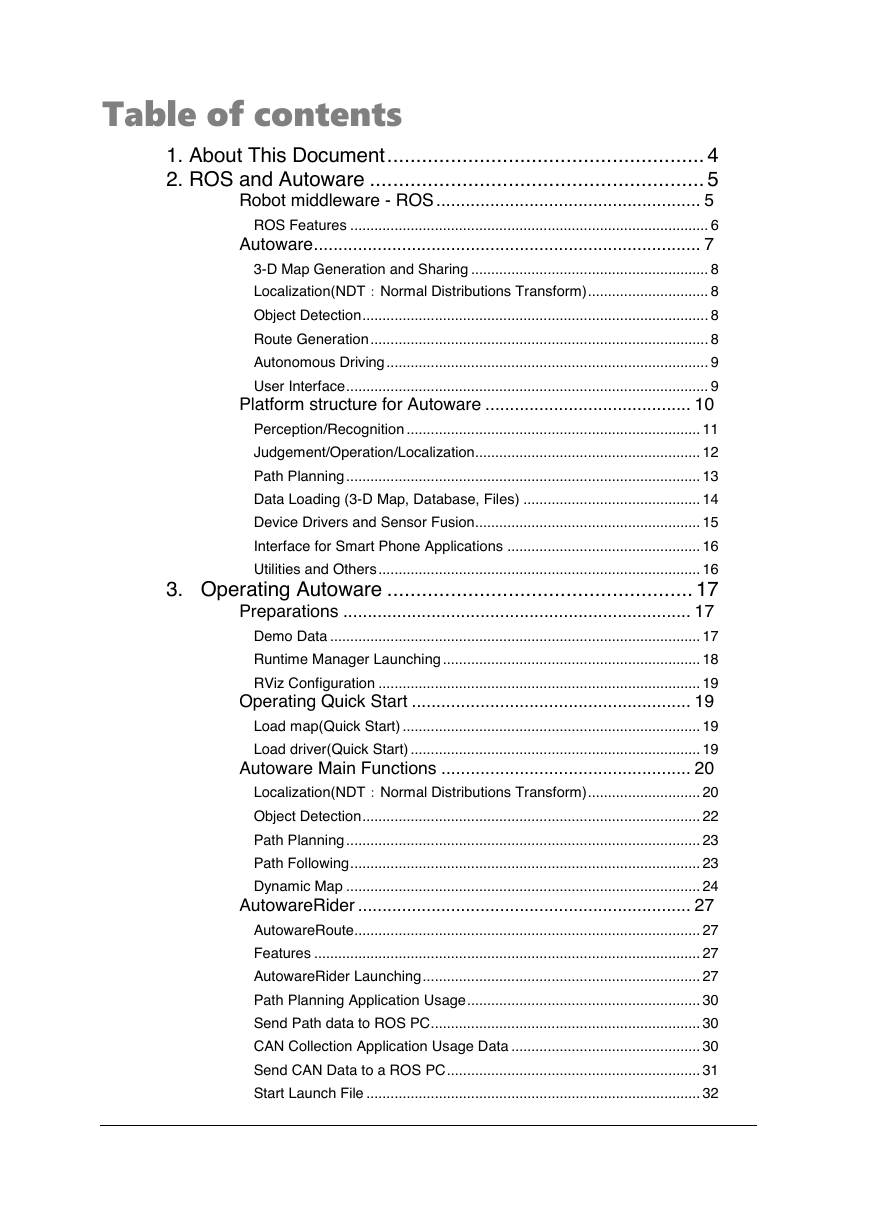
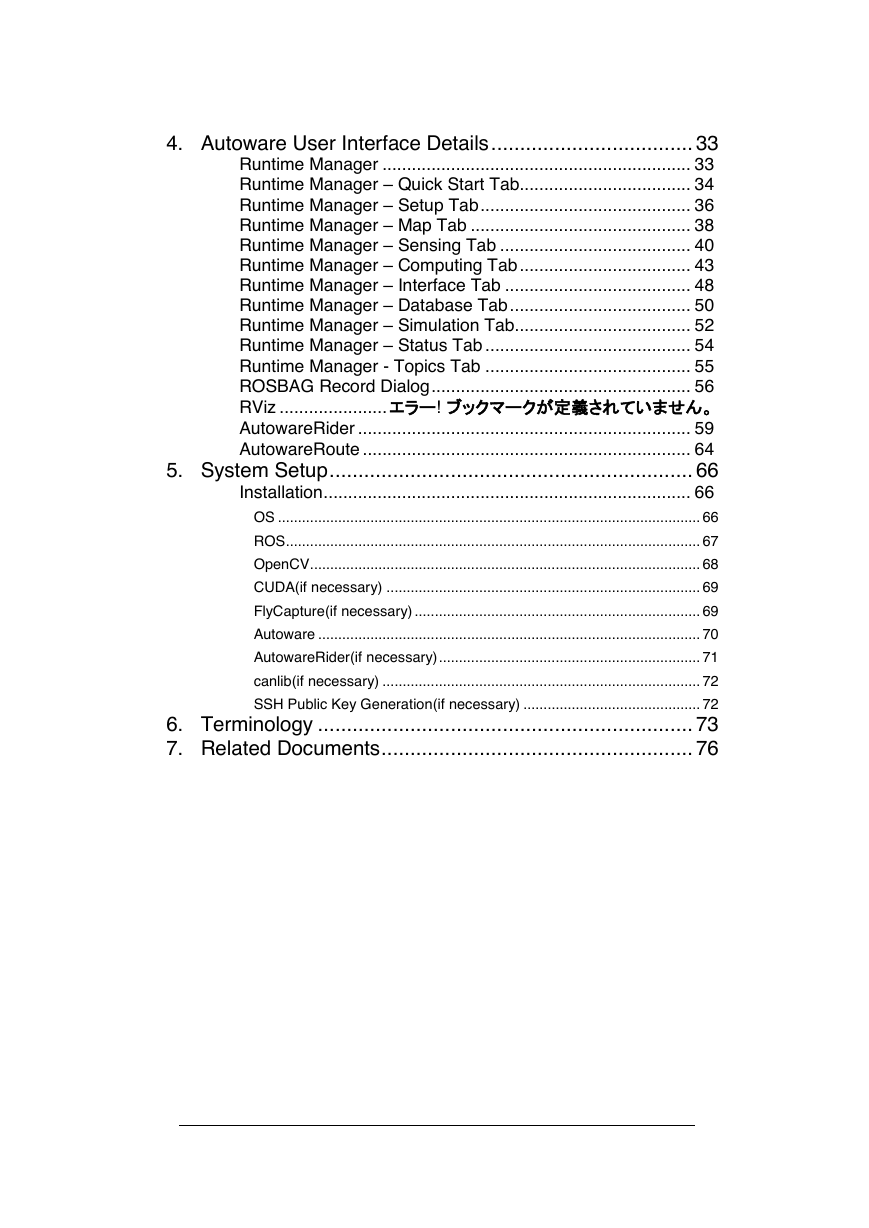
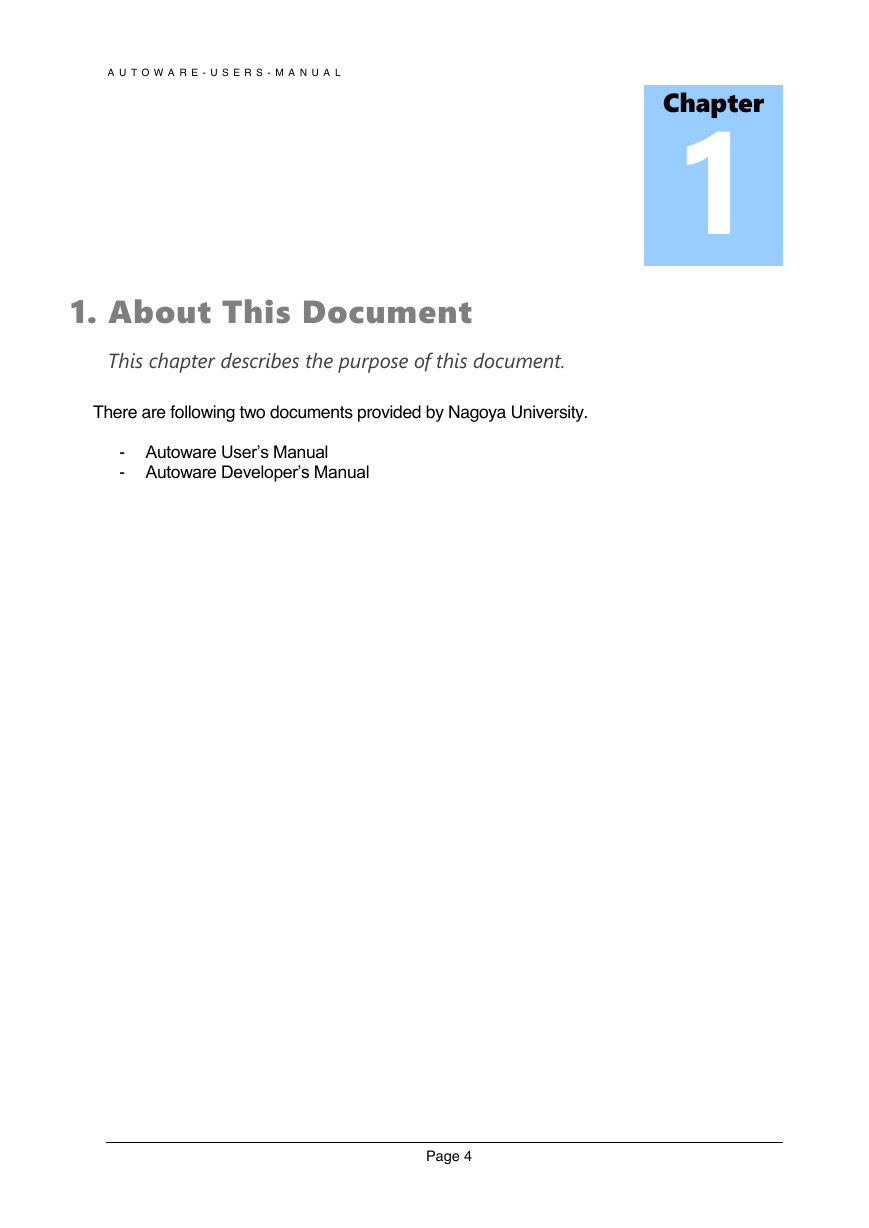
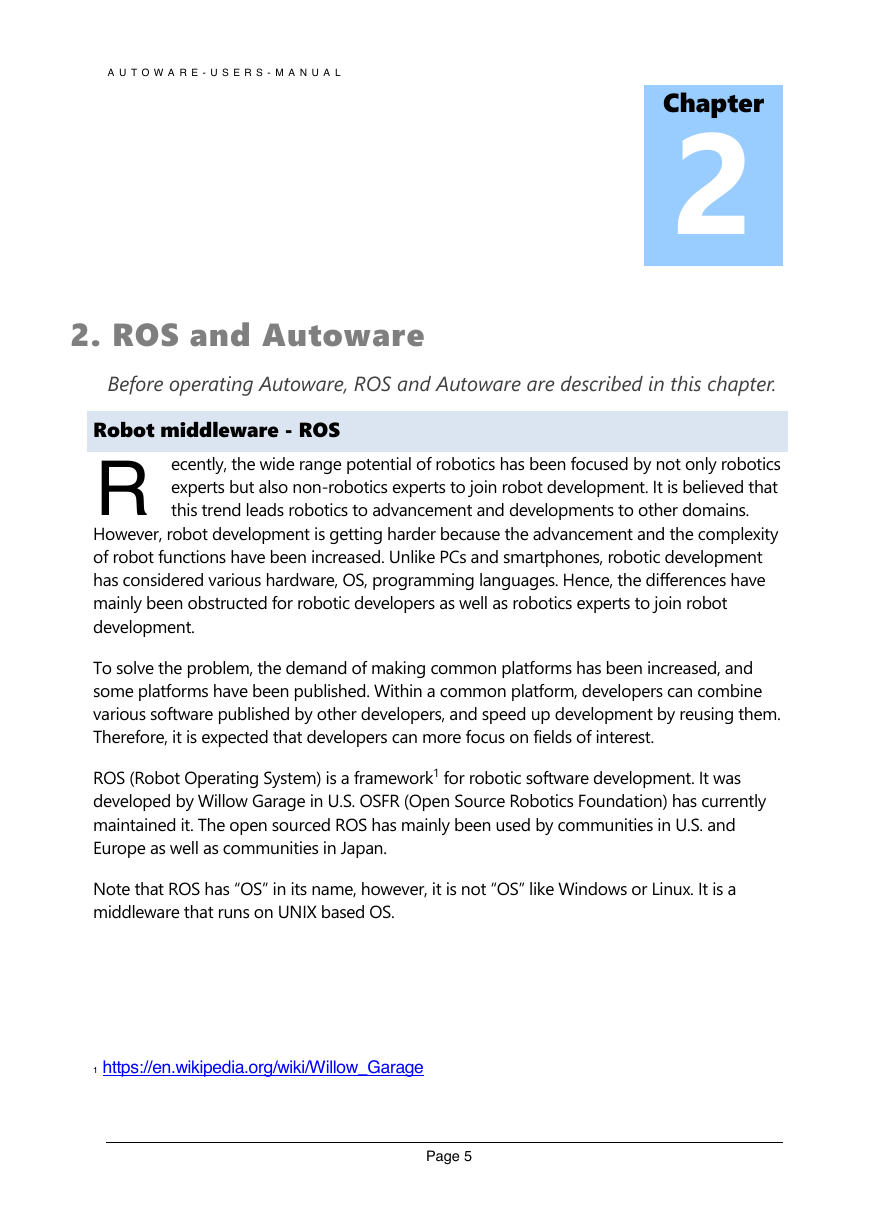
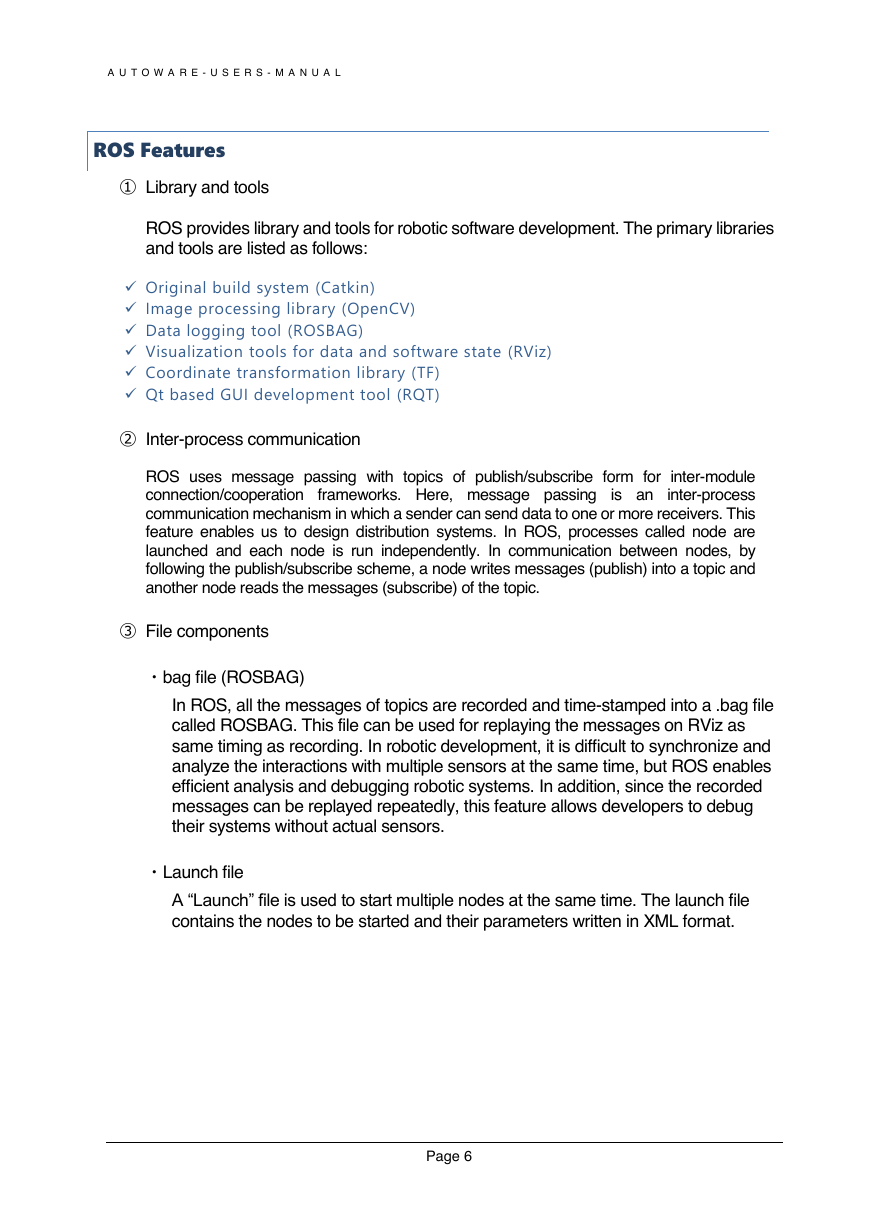

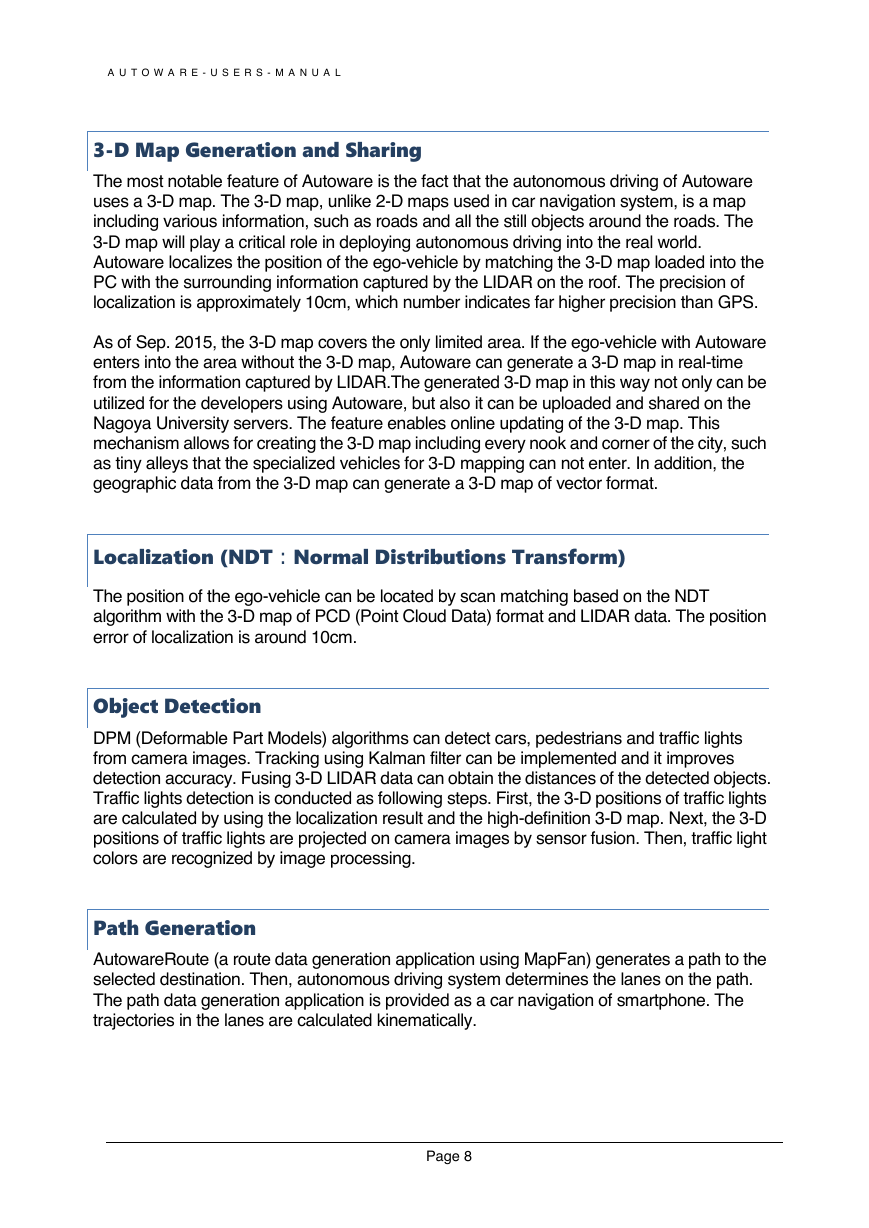








 2023年江西萍乡中考道德与法治真题及答案.doc
2023年江西萍乡中考道德与法治真题及答案.doc 2012年重庆南川中考生物真题及答案.doc
2012年重庆南川中考生物真题及答案.doc 2013年江西师范大学地理学综合及文艺理论基础考研真题.doc
2013年江西师范大学地理学综合及文艺理论基础考研真题.doc 2020年四川甘孜小升初语文真题及答案I卷.doc
2020年四川甘孜小升初语文真题及答案I卷.doc 2020年注册岩土工程师专业基础考试真题及答案.doc
2020年注册岩土工程师专业基础考试真题及答案.doc 2023-2024学年福建省厦门市九年级上学期数学月考试题及答案.doc
2023-2024学年福建省厦门市九年级上学期数学月考试题及答案.doc 2021-2022学年辽宁省沈阳市大东区九年级上学期语文期末试题及答案.doc
2021-2022学年辽宁省沈阳市大东区九年级上学期语文期末试题及答案.doc 2022-2023学年北京东城区初三第一学期物理期末试卷及答案.doc
2022-2023学年北京东城区初三第一学期物理期末试卷及答案.doc 2018上半年江西教师资格初中地理学科知识与教学能力真题及答案.doc
2018上半年江西教师资格初中地理学科知识与教学能力真题及答案.doc 2012年河北国家公务员申论考试真题及答案-省级.doc
2012年河北国家公务员申论考试真题及答案-省级.doc 2020-2021学年江苏省扬州市江都区邵樊片九年级上学期数学第一次质量检测试题及答案.doc
2020-2021学年江苏省扬州市江都区邵樊片九年级上学期数学第一次质量检测试题及答案.doc 2022下半年黑龙江教师资格证中学综合素质真题及答案.doc
2022下半年黑龙江教师资格证中学综合素质真题及答案.doc